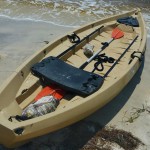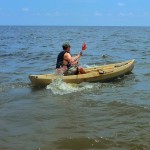The idea of intentionally pursuing what is arguably the most dynamic predator the world has ever known means reaching the pinnacle of the angling experience. Shark fishing is taboo. It is generally the rustic disregard for more common practices of complex fishing pursuits simplified to nothing more than the thrill of catching something big, mean, and dangerous. The thrill of tangling with a large shark is hard to chronicle but even the most seasoned shark anglers are familiar with the sweaty palms and tingling spine resulting from a breached dorsal cutting through the water’s surface.
One cannot have casual conversation on the topic of dangerous predators without placing some species of shark at or near the top. It is an animal so crowded with fable and lore that every year millions of people anchor themselves to the couch with popcorn in hand to tune into an entire week devoted to them. Even in the landlocked comfort of our own living room we are forced to respect an animal that has dominated its ecosystem for nearly as long as human beings have had an intelligent means by which to document time. Anglers take it a step further.

There are a lot of different ways to pursue sharks, but regardless of the foundation we squarely plant our feet in battle; be it boat, dock, bridge, or shore, the hands are still sticky with blood, salt, and sweat. Land based shark fisherman are often ill-equipped to pursue sharks by vessel, but many simply prefer the thrill of bringing this creature to the shore. Beach goers are taught from an early age that sharks do not belong on the beach, or that we do not belong on the beach while sharks are there. Many beaches are lined with warning signs and stations particularly designed to bring attention to the realistic threat that swimmers can and have been killed and maimed by this animal. Where the threat of such peril sends most heading for high ground, some folks are crazy enough to lug a bloody fish carcass out into those waters with a kayak!
In my experience with land based shark fishing it is the paddle out that instills most fear within me. The fear of the unknown and the ever present reality that those animals are underneath, coupled with the darkness of the night and the chop of a turbid sea fuels the stroke of a paddle that may be over 400 yards from the safety of the shore. Landing a shark is personal and intimidating, but the threat can mostly be seen and assessed, and the fish is usually well fatigued. De-hooking a landed shark is close quarter and places the angler into immediate danger but by this stage there is more respect and awe than fear or anxiety. I tell you, it is the paddle out that really sells it for land based shark anglers. You become surrounded by an ocean with no shortage of danger. Separated from the safety and comfort of a solid ground where phones, friends, or ambulance can be of immediate assistance. Every stroke of the paddle separates you from those things and the mind races. Where this conflicts with appropriate tactic is that bait deployment by this method is crucially important.

Anglers who intend to deliver a bait by kayak should do their research. It starts days in advance and there are more than enough dangers involved to warrant some safety precaution and preparation. Weather reports should be followed and documented daily leading up to a planned excursion. High pressure, wind, or current can create violent surf. Inexperienced paddlers should take the time to prepare accordingly and that could be as simple as wearing a lifejacket, having a noise maker, or simply not going in the first place if the seas will be rough. Keep in mind that while paddling out, the bait is in tow or in the kayak with you. That means there is fishing line, wire, and hooks that could create obvious problems should one get dumped over and washed around by a big wave. That may also mean getting a paddle tether. A paddle tether will prevent an angler from losing his only means by which to engine the kayak.

Recognition of current movement is important because that is generally the direction that the waves are coming from and for safety purposes you usually want to paddle nose first into the rollers. To be tactically sound, anglers should angle the direction the paddle and place a bait towards the current for both safety reasons and to compensate for drag or pull of a bait. Swift currents can displace a bait by pushing them far away from the intended drop location.
Using Google Earth or other satellite imagery is a must. Satellite images of the surf will show where the sandbars are at. That is where the waves are cresting and from the high vantage of satellite imagery you can usually see two to three long rows of white cresting water near where the ocean meets the land. Most anglers prefer to place their baits beyond the last sandbar, but there is often great fishing to be had between bars. Sharks will move in closer to shore during high tides and during overcast conditions. They are usually further out when the sun is bright or at lower tides. Because of this anglers should familiarize themselves with tide charts and weather reports.
An angler seeking to utilize a kayak in the surf should also know the differences between kayak variations. A kayak used in white water and for diving off of a waterfall may not be convenient for the ocean. There are many kayaks designed specifically for ocean use. Ocean Kayak manufactures a number of quality models for bait deployment.
Kayaking can be the funnest part of land based shark fishing, short of actually catching the fish, but it can also be the most dangerous. Anglers should be extremely cognizant of the dangers involved and keen focus is utmost importance during the paddle out.















